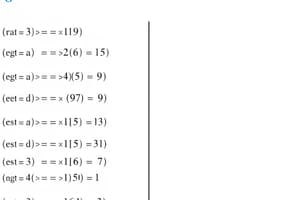Podcast
Questions and Answers
Which of the following describes a valid use of Baye's theorem?
Which of the following describes a valid use of Baye's theorem?
- Determining the probability of an event given prior knowledge (correct)
- Finding the median of a data set
- Evaluating independent event probabilities
- Calculating the mean of a sample
What is a characteristic feature of a synchronous sequential system?
What is a characteristic feature of a synchronous sequential system?
- Output depends only on current inputs
- Utilizes memory without a feedback loop
- State changes occur at discrete time intervals determined by a clock (correct)
- Outputs change independently of the clock signal
In the context of data structures, what does a stack primarily utilize?
In the context of data structures, what does a stack primarily utilize?
- Sorted ordering for retrieval
- First-In-First-Out (FIFO) ordering
- Last-In-First-Out (LIFO) ordering (correct)
- A balanced binary tree format
Which of the following is NOT a basic principle of Object-Oriented Programming?
Which of the following is NOT a basic principle of Object-Oriented Programming?
What does the linear regression technique analyze?
What does the linear regression technique analyze?
Which of the following best describes a binary tree?
Which of the following best describes a binary tree?
What is the function of a control unit in a CPU?
What is the function of a control unit in a CPU?
Which statement about hashing is incorrect?
Which statement about hashing is incorrect?
What is a critical aspect of the ACID properties in database transactions?
What is a critical aspect of the ACID properties in database transactions?
Which of the following is NOT characteristic of the OSI reference model?
Which of the following is NOT characteristic of the OSI reference model?
Which of the following is true for Java applets?
Which of the following is true for Java applets?
Which normalization form requires that there be no repeating groups?
Which normalization form requires that there be no repeating groups?
Which protocol is used for secure email transmission?
Which protocol is used for secure email transmission?
In web programming, which of the following technologies is used for server-side scripting?
In web programming, which of the following technologies is used for server-side scripting?
Which of the following classes or structures is not typically part of Java's multithreading support?
Which of the following classes or structures is not typically part of Java's multithreading support?
Which type of model describes the behavior of a system in software engineering?
Which type of model describes the behavior of a system in software engineering?
Flashcards
Logical AND
Logical AND
A logical operator that combines two propositions and outputs 'true' only if both propositions are true.
Logical OR
Logical OR
A logical operator that combines two propositions and outputs 'true' if at least one of the propositions is true.
Set
Set
Represents a collection of distinct elements.
Binary Relation
Binary Relation
Signup and view all the flashcards
Linked List
Linked List
Signup and view all the flashcards
Stack
Stack
Signup and view all the flashcards
Queue
Queue
Signup and view all the flashcards
Byte
Byte
Signup and view all the flashcards
Java Applets
Java Applets
Signup and view all the flashcards
Bytecode
Bytecode
Signup and view all the flashcards
Classes in Java
Classes in Java
Signup and view all the flashcards
Wrapper Classes
Wrapper Classes
Signup and view all the flashcards
The Applet Class
The Applet Class
Signup and view all the flashcards
E-R Model
E-R Model
Signup and view all the flashcards
Normalization
Normalization
Signup and view all the flashcards
ACID Properties
ACID Properties
Signup and view all the flashcards
Study Notes
Discrete Mathematics, Probability and Statistics
- Compound statements, truth tables, propositional logic
- Logical arguments, sets, operations on sets
- Binary relations, partial orders, mathematical induction
- Principle of inclusion-exclusion
- Probability theory: sample spaces, events, probability
- Discrete probability: union, intersection, complement of events
- Conditional probability, Bayes' theorem
- Linear correlation coefficient, linear regression, non-linear regression
- Theory of sampling and population
Digital Electronics, Computer Organization and Operating System
- Digital logic systems, K-maps, TTL and CMOS logic families
- Combinational logic design, synchronous sequential system design
- Microprocessors: 8086 architecture, data transfer scheme and interfaces
- Addressing modes
- Computer organization and architecture: Von-Neumann architecture
- Registers, micro-operations, control logic, processor addressing, bus organization
- Processor input/output, DMA, Memory organization, cache coherence
- Operating Systems: CPU scheduling, Deadlocks, Memory management, file systems
- Disk scheduling, process, threads, synchronization
- Real-time OS: clock synchronization, task scheduling, system initialization
- Booting, user account handling, backup and restore, Bourne shell programming for Linux
Data Structures and Programming in C
- Data Structures: Linked List, Stack, Queue, Priority Queues, Hashing, Binary trees
- Tree traversal, AVL trees, graphs- shortest paths, minimum spanning trees
- Sorting algorithms
- Programming in C: Operators and expressions, Control statements, Storage types
- Functions, Arrays, Strings, Structures, Pointers, dynamic memory management
- File handling
Object Oriented Programming through C++/Java
- Data Abstraction, Encapsulation, classes, constructors and destructors
- Classes, dynamic memory allocation, Inheritance, Polymorphism, generic classes
- Exception handling, File processing
- Java applets, Java features, Byte codes, Internet classes, wrapper classes
- Multithreading support classes, vector, stack, interface observer, stream
Database Management System
- Keys, E-R Model, Normalization (1NF to 5NF)
- Aggregate functions, nested subqueries, Views, Joined Relations
- Transaction - ACID properties, Concurrency Control, triggers, stored procedures
Client Server Architectures and Web Programming
- Two and three-tier client server architectures
- Web servers, HTML & XML, Style Sheets, client-side scripting (JavaScript and VB Script)
- Server-side scripting (PHP, JSP, ASP.NET)
- Dynamic web pages using databases, forms and sessions
- AJAX and SignalR
Computer Networks and Programming
- Computer networks and security
- TCP/IP & OSI/ISO reference models, functions and protocols of different layers
- Characteristics of physical media, multiplexing, medium access protocols
- 802.3, 802.4, 802.5, 802.11 LAN technology, IP protocol
- Routing, congestion control, TCP and UDP, DNS, Email protocols
- Symmetric and asymmetric encryption (DES, AES, IDEA, RSA)
- Key management, viruses, trusted systems, Kerberos
- Network Programming: Sockets Programming (TCP, UDP)
- TELNET, HTTP, UDP Sockets (TFTP, DNS), Secure Sockets (SSL), TLS, SSH, HTTPS
- Remote Method Invocation (RMI), Simple Object Access Protocol (SOAP), UDDI, and Web Services
Software Engineering
- System modeling, system engineering process, life cycle models
- Design and Implementation, validation, evolution, automated process support
- Software requirements, SRS, feasibility studies, elicitation, analysis, validation management
- System models, context models, behavior models, data models, object models
- Object-oriented design, design evolution, real-time software design, critical system development
- Software testing
Studying That Suits You
Use AI to generate personalized quizzes and flashcards to suit your learning preferences.




